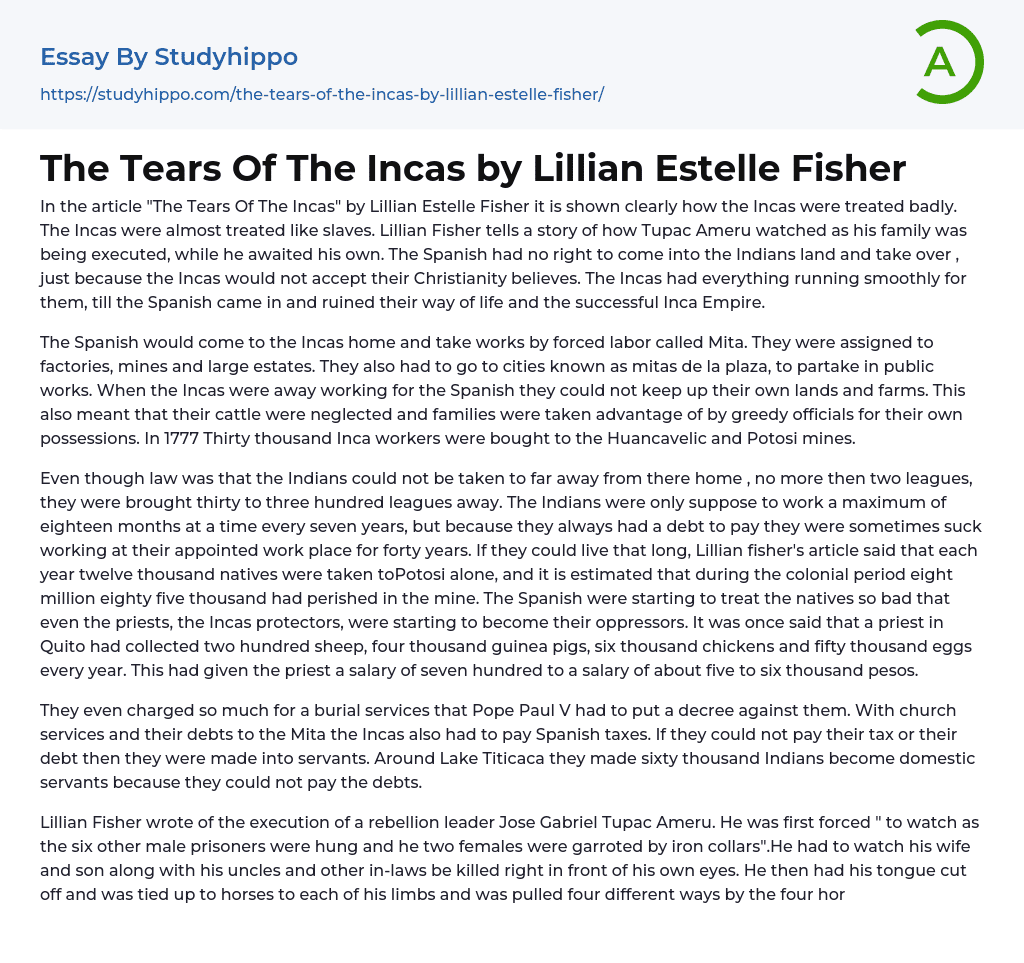

The Tears Of The Incas by Lillian Estelle Fisher Essay Example
In "The Tears Of The Incas" article authored by Lillian Estelle Fisher, it is explicitly illustrated how the Incas suffered mistreatment akin to that of slaves. Lillian Fisher narrates a story of Tupac Ameru, who witnessed the execution of his family before waiting for his turn. The Spanish illegally dominated the Indian land and altered the successful Inca Empire just because the Incas opposed their Christianity beliefs. The Incas enjoyed a smooth-sailing existence until the Spanish disrupted their way of life.
During the time of the Incas, the Spanish would make them engage in forced labor called Mita, which entailed taking their works. The Incas were given tasks in factories, mines, and large estates, and also had to travel to cities known as mitas de la plaza to work on public projects. As a result of working for the S
...panish, the Incas were unable to maintain their own farms and lands, which led to neglect of their cattle and families being exploited by avaricious officials who desired their possessions. In 1777, a total of thirty thousand Inca workers were brought to work in the Huancavelic and Potosi mines.
Despite the law stipulating that Indians could not be taken more than two leagues away from their homes, they were transported up to three hundred leagues. The law mandated that they should work for a maximum of eighteen months at a time every seven years, but due to their ongoing debts, they could sometimes be forced to work for forty years at their place of employment. Unfortunately, Lillian Fisher's article revealed that each year, twelve thousand natives were taken to Potosi alone, and eight million eighty-five thousand perished i
the mines during the colonial era. The Spanish began to mistreat the natives to such an extent that even the priests--the protectors of the Incas--became oppressors. One priest in Quito was reported to have collected 200 sheep, 4,000 guinea pigs, 6,000 chickens, and 50,000 eggs annually, giving him an annual income of between 700 and 5,000 to 6,000 pesos.
The Incas were faced with numerous financial burdens, including high charges for burial services that resulted in Pope Paul V issuing a decree against the service providers. Additionally, the Incas were required to pay Spanish taxes and their debts to the Mita, which were often difficult to manage. Failure to pay these debts often meant being forced into servitude as a means of repayment. In fact, around Lake Titicaca alone, approximately 60,000 Indians were made into domestic servants due to their inability to pay their debts.
Lillian Fisher recorded the cruel mistreatment of Jose Gabriel Tupac Ameru, who was a leader in the rebellion. He had to witness six male prisoners being hanged and two females being strangled with iron collars before he was executed himself. Moreover, his family members, including his wife, son, uncles, and in-laws were killed too. His torment continued as he had his tongue cut off and was tied to four horses that pulled him apart limb by limb.
Despite his strong build, he was eventually decapitated and dismembered, with his limbs scattered across Peru as a message to potential rebels against the Spanish. The Incas were forced to resist due to their mistreatment and enslavement by the conquerors, who viewed them as mere household workers because of their intense suffering.
By executing the
rebel leader and his family, the Spanish demonstrated their cruelty. In addition, the Incas received no assistance from the king due to the Corregidors' greed. Therefore, the Spanish invasion and conquest of native lands were unjustifiable.
- Poison essays
- Action Potential essays
- Nervous System essays
- Childbirth essays
- Puberty essays
- Blood essays
- Kidney essays
- Neuron essays
- Body essays
- Glucose essays
- Sense essays
- Heart essays
- Skeleton essays
- Human Physiology essays
- Eye essays
- Immune System essays
- Muscle essays
- Skin essays
- Brain essays
- Central Nervous System essays
- Human Skin Color essays
- Digestive System essays
- Common sense essays
- Respiration essays
- Slave Trade essays
- Addiction essays
- Anatomy and Physiology essays
- Biodegradation essays
- Cancer essays
- Dental Care essays
- Disability essays
- Disease essays
- Disorders essays
- Health Care essays
- Infectious Disease essays
- Inquiry essays
- Intelligence Quotient essays
- Lung Cancer essays
- Medicine essays
- Neurology essays
- Nutrition essays
- Olfaction essays
- Physical Exercise essays
- Public Health essays
- Sex essays
- Women's Health essays
- World health organization essays
- Administration essays
- Architect essays
- Discipline essays



